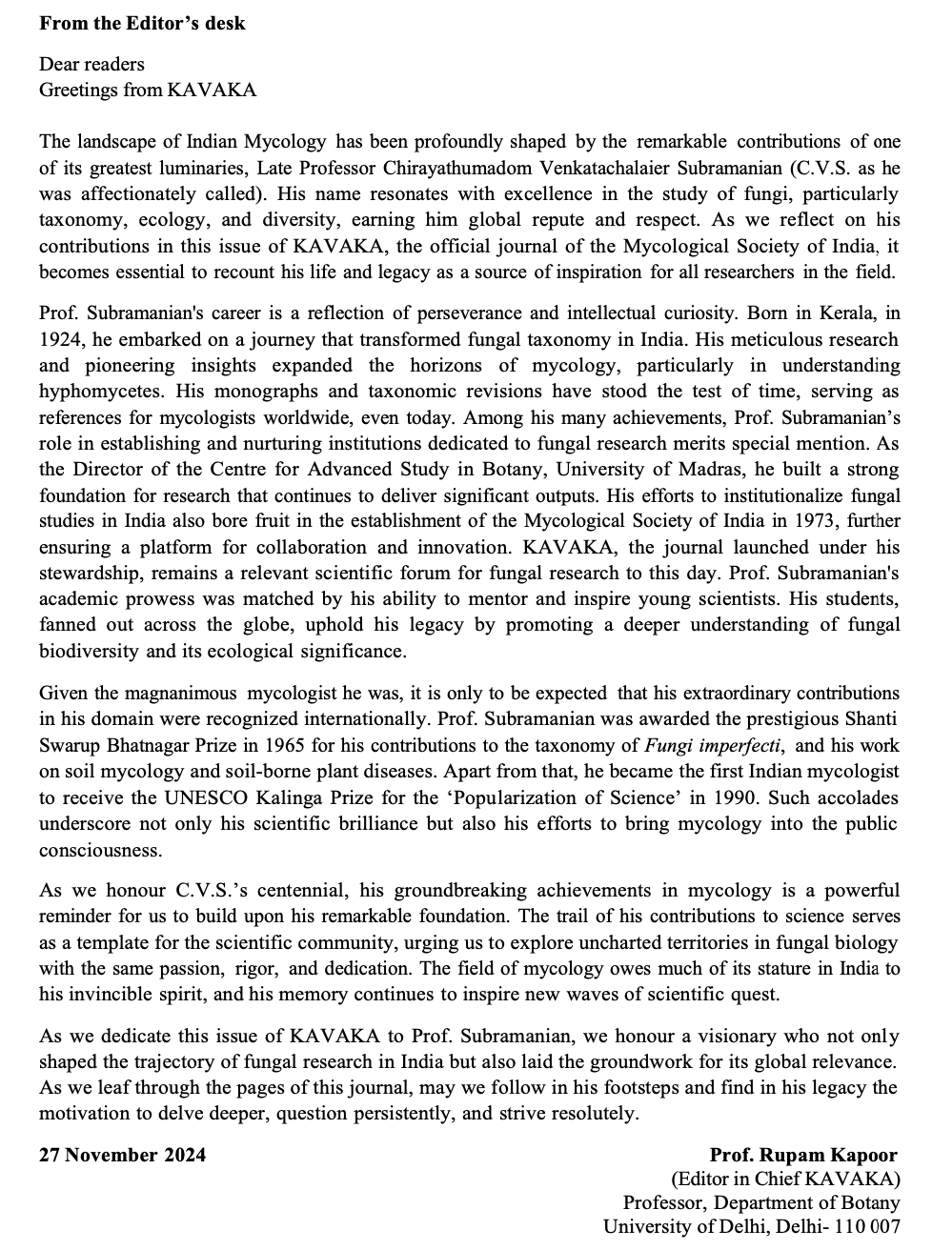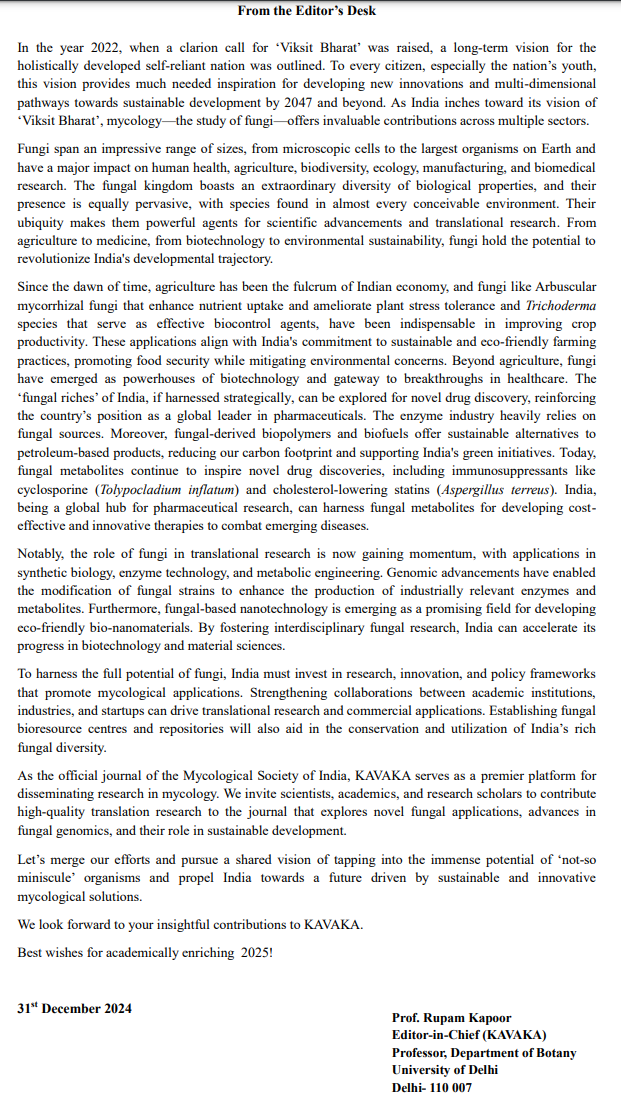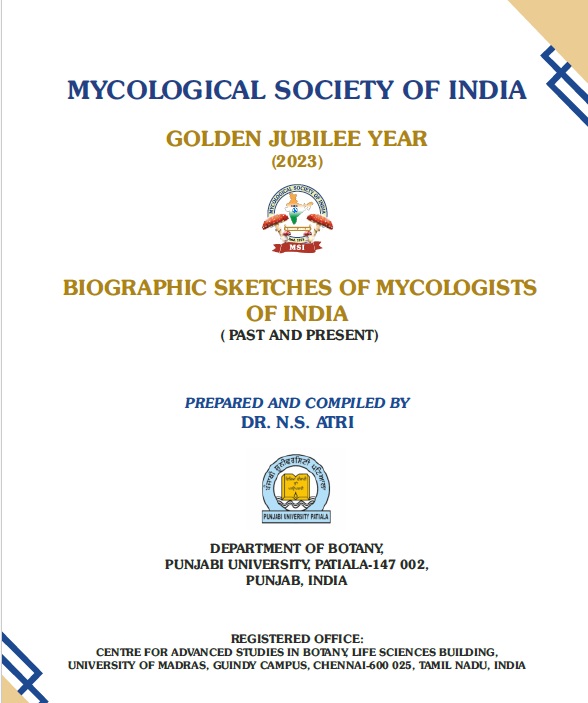
KAVAKA 60 Special Issue: 1-11 (November 2024)
DOI: 10.36460/Kavaka/60/sp/2024/1-11
BIOGRAPHICAL SKETCHES OF PROF. C.V. SUBRAMANIAN
N. Raaman
Centre for Advanced Studies in Botany, Former Secretary & Former President of Mycological Society of India, University of Madras, Guindy Campus, Chennai - 600 025, India.
Email: This email address is being protected from spambots. You need JavaScript enabled to view it.
Prof. C.V. Subramanian (August 11, 1924 – February 5, 2016)
Late Professor Chirayathumadom Venkatachalaier Subramanian, affectionately referred to as CVS, was an internationally renowned and most distinguished mycologist of our country. Professor Subramanian was 'a complete mycologist'. His knowledge of fungi extended much beyond the Hyphomycetes. He was one of the first to grasp the importance of 'diversity' studies in different ecological habitats and apply these in systematics of fungi. Late Professor Subramanian’s academic distinctions to the growth of science of Mycology have been recognized both in India and abroad. In 2005, the then Director of CMI, Prof. Hawksworth referred to Prof. CVS as “The Uncontested Father of Mycology”.
KAVAKA 60 Special Issue: 12-29 (November 2024)
DOI: 10.36460/Kavaka/60/sp/2024/12-29
Professor R.N. Kharwar
President, Mycological Society of India (2024)
Professor R.N. Kharwar
President, Mycological Society of India (2024)
R.N. Kharwar
Mycopathology and Microbial Technology Laboratory, Department of Botany, Institute of Science, Banaras Hindu University, Varanasi - 221 005, India.
*Corresponding author Email: This email address is being protected from spambots. You need JavaScript enabled to view it.
ABSTRACT
This review reveals about the shift from epiphytic to endophytic fungi based on works of my own and others, examining their ecological functions, diversity and potential applications in biotechnology. The epiphytic fungi colonize plant surface and play crucial roles in nutrient cycling and microbial diversity across the ecosystems while endophytic fungi live within the plant tissues, forming symbiotic relationships that can boost plant growth, resilience to stress and resistance to diseases. The research utilizes a comprehensive approach, combining the field observations, molecular methods, and ecological evaluations to contrast fungal populations in epiphytic and endophytic environments. The observations demonstrate unique patterns of fungal diversity, with certain species showing preferences for either space or nutrients. These findings have significant ecological implications, emphasizing the importance of comprehending fungal interactions with their host plant. Furthermore, the study identifies several fungal strains with promising biotechnological uses such as biological control agents and producers of bioactive compounds. This review not only deepens our knowledge of fungal ecology, but also showcases the potential of these organisms in sustainable farming and environmental stewardship. By examining the transition from surface to internal colonizers, the mentioned facts offer valuable insights into fungal biology and their roles in ecosystem processes and advancements in agricultural and pharma industries.
Keywords: Endophytes, Epiphytes, Fungal diversity, Applications, Ecological aspects.
KAVAKA 60 Special Issue: 30-53 (November 2024)
DOI: 10.36460/Kavaka/60/sp/2024/30-53
Strain Improvement and Molecular Characterization of Mushrooms 
N. Raaman* and P. Selvakumar
Centre for Advanced Studies in Botany, University of Madras, Guindy Campus, Chennai - 600 025, India.
*Corresponding author Email: This email address is being protected from spambots. You need JavaScript enabled to view it.
(Submitted on March 1, 2024; Accepted on September 1, 2024)
ABSTRACT
Mushrooms are valued as highly tasty and nutritional food and considered to be a rich source of proteins, amino acids, carbohydrates, vitamins and minerals. Therefore, mushrooms are called as functional food. The breeding of new strains has significantly improved, allowing the use of strains with high yield, quality, texture, colour and taste, increasing productivity and diminishing the use of chemicals for pest control. Strain improvement of mushroom species thus far has been based on conventional breeding methods. However, breeding of improved strains by conventional methods is a labour intensive and time-consuming procedure. Hence, the protoplast fusion has been used as a method to create mushroom hybrids, especially when using conventional methods cannot achieve this result. This technique opened up an new area of study, which has both fundamental and applied importance. Protoplast fusion is an appropriate method in creating hybrids of interspecific hybridization in mushrooms Strain improvement is one of the important methods in mushroom technology to improve its potential towards industrial and pharmaceutical point of view. The protoplast fusion is potentially important technique for genetic manipulation of industrially important fungi, obtaining valuable hybrids with disease resistance and for production of quality products in cultivated plants in agriculture. Combinations of desirable traits are possible in recent days through protoplast fusion.
Key Words: Mushrooms, Strain improvement, Conventional techniques, Protoplast fusion, Isolation of viable fungal protoplast, Fusion methods of protoplast, Regeneration and reversion of protoplast, Molecular characterization
KAVAKA 60 Special Issue: 54-76 (November 2024)
DOI: 10.36460/Kavaka/60/sp/2024/54-76
Mushrooms in Service of the Society and the Environment
N.S. Atri
Department of Botany, Punjabi University, Patiala - 147 002, Punjab, India.
Corresponding author Email: This email address is being protected from spambots. You need JavaScript enabled to view it.
(Submitted on March 17, 2024; Accepted on September 10, 2024)
ABSTRACT
Mushrooms are cosmopolitan and epigeous or even hypogeous. They produce varied morphological forms which grow either solitary or scattered to gregarious or in cespitose clusters on variety of substrates and some may even form fairy rings as well. Ecological parameters such as soil type, pH, relative humidity, temperature, altitude, association with trees, specificity, geographical coordinates, etc., play a determinate role in mushroom growth, phenology and their distribution. These are categorized as minor forest products having number of applications as for their utility in human welfare is concerned. Besides their nutritional and nutraceutical importance, they are a source of revenue and provide opportunities for the entrepreneurs to venture into the area of cultivation of nutritionally and medicinally important mushrooms and explore opportunities in value addition as a source of revenue generation. Agaricus bisporus, Lentinula edodes, Pleurotus spp., Volvariella volvacea, Calocybe indica are some such mushrooms which are being cultivated on commercial scale and are in use for value addition as well. There are number of them including Cordyceps militaris, C. sinensis, Morchella esculenta, Termitomyces heimii, Coprinus comatus, Podaxis pistillaris, Phellorinia inquinens, etc., which are collected from the wild and sold in the local markets for earning extra revenue or even dried for use in the off season. Mushrooms have been in use since times immemorial as folk medicine. Many of these including Cordyceps militaris, C. sinensis, Grifola frondosa, Tramates versicolor, Gandoderma lucidum, Psilocybe mexicana, etc., are important source of bioactive molecules having applications in therapeutics. Many of the mushrooms are saprophytic which play an important role in recycling the organic wastes and some are mycorrhizal, which help in improving the health of the plants by forming mutualistic association. Other important aspects where mushroom mycelia and their sporophores have found applications include bioremediation, mycofiltration, as objects of beauty and mystique, in the synthesis of building and packaging material, in the preparation of cosmeceuticals or nutricosmetics and as a source of natural colors. Because of such wide range of applications mushrooms are referred as special creation of God.
Keywords: Mushrooms, Nutritional, Nutraceutical, Bioactive compounds, Mycorrhizal, Lectins, Nanoparticle, Bioremediation, Biotransformation, Mycofiltration, Biocomposite.
KAVAKA 60 Special Issue: 77-83 (November 2024)
DOI: 10.36460/Kavaka/60/sp/2024/77-83
Halophilic Aspergillus penicillioides - a Specialist Group of Fungus and its Morphological Adaptations in Hypersaline Environments
Valerie Gonsalves*1 and Sarita W. Nazareth2
1Department of Microbiology, St. Xavier’s College, Goa, India.
2 Retired Senior Professor, Goa University, Taleigao Plateau, Goa, India.
*Corresponding author Email: This email address is being protected from spambots. You need JavaScript enabled to view it.
(Submitted on July 7, 2024; Accepted on September 10, 2024)
ABSTRACT
Halophilic fungi undergo various changes that enable them to adapt to osmotic pressure as well as toxicity of salt in the environment. Although several studies have been investigated on osmoadaptations of halophilic fungi to saline conditions, there are few reports on analysis of the fungal mechanisms occurring at micro and macro morphological levels that enable fungi to survive in saline environments. The current work reports the effects of salt on colony growth and micromorphology in obligate Aspergillus penicillioides and its mechanism of survival in saline environments.
Keywords: Aspergillus penicillioides, Obligate halophile, Colony, Micromorphology, Specialist fungus.
KAVAKA 60 Special Issue: 84-92 (November 2024)
DOI: 10.36460/Kavaka/60/sp/2024/84-92
Effects of Physicochemical Factors on Vegetative Growth of Lentinus cladopus - A Wild Edible Mushroom
Lata1 and Gaurav Bhakri2*
1Department of Life Sciences, Sharda School of Basic Sciences & Research, Sharda University, Greater Noida - 201 308, Uttar Pradesh, India.
2Department of Chemistry & Biochemistry, Sharda School of Basic Sciences & Research, Sharda University, Greater Noida - 201 308, Uttar Pradesh, India.
*Corresponding author Email: This email address is being protected from spambots. You need JavaScript enabled to view it.
(Submitted on August 31, 2024; Accepted on September 22, 2024)
ABSTRACT
Lentinus cladopus Lév is an edible lignicolous mushroom which was collected from the wild and subsequently cultured with a view to investigate the effect of variable temperatures, incubation period, pH and different carbon and nitrogen sources for maximum mycelia growth. During the investigations undertaken optimum temperature of 30±1 °C, incubation period of 10 days and pH ranging between 4.0-5.0. Dextrose amongst the carbon sources and Glycine amongst the nitrogen sources were found to support maximum vegetative growth.
Keywords: Lentinus cladopus, Incubation period, Vegetative growth, pH, Carbon sources, Nitrogen sources.
KAVAKA 60 Special Issue: 93-106 (November 2024)
DOI: 10.36460/Kavaka/60/sp/2024/93-106
Perspectives of Yeast, Molds and Mushrooms as Pro and Prebiotics for the Improvement of Gut Health and Microbiome: A Review
Devaraja Gayathri*, Rajanna Soundarya, G.S. Shwetha and S.M. Pruthvi
Department of Studies in Microbiology, Davangere University, Shivagangothri, SH-76, Davangere - 577 007, Karnataka State, India.
*Corresponding author Email: This email address is being protected from spambots. You need JavaScript enabled to view it.
(Submitted on June 21, 2024; Accepted on 25 September, 2024)
ABSTRACT
Probiotics are diverse live microorganisms (including bacteria, yeasts and molds) that confer good number of health promoting activities to the host when ingested in adequate amount. Functional foods are fortified with these probiotics and have improved human health in addition to the therapeutic applications. In addition to Lactobacilli and Bifdobacteria, good number of yeast, molds and mushrooms act as pre and probiotics and thus help in health promotion. The ability to survive in the gastrointestinal tract, salt tolerance and adherence to intestinal epithelial cells, co/auto aggregation are the few prerequisites to be probiotics. In this review, we emphasise and promote the use of fungal strains (yeasts, mold and mushroom) as pre and probiotics for immunomodulatory effects and for functional properties. Thus, fungal species would be promising candidate as pre/probiotic strains.
Key words: Saccharomyces, Aspergillus oryzae, Inulin, Fructans, Probiotics, Prebiotics, Synbiotics, Mushrooms
KAVAKA 60 Special Issue: 107-118 (November 2024)
DOI: 10.36460/Kavaka/60/sp/2024/107-118
Epicoccum sorghinum as a Potential Source for Pigment Production
Pushpa, H.1*, Saritha, M.1, Vishal, M.,2 and Savitha, J.3
1*,2,3Department of Microbiology, M.S. Ramaiah college of Arts, Science and Commerce - Autonomous, Bengaluru - 560 064, Karnataka, India.
1Podar International School, Beed - 431 122, Maharashtra, India.
*Corresponding author Email: This email address is being protected from spambots. You need JavaScript enabled to view it.
(Submitted on August 10, 2024; Accepted on October 7, 2024)
ABSTRACT
The present study aimed to screen pigment producing microorganisms from various sources. Three pigment-producing bacteria and 6 pigment producing fungi were isolated and characterized. Among the fungi, Epicoccum sorghinum was selected for further investigation due to the limited research on its pigment production and applications. Optimization of biomass and pigment production was investigated under various growth parameters. Our investigation revealed that pigment production was minimum at 35°C and maximum at 25°C, with optimal production at pH 7.0. Fructose and organic nitrogen were most suitable for mycelial growth and pigment production as a carbon and nitrogen source, respectively. Mutational studies on E. sorghinum were performed to observe changes of UV and N-methyl-N′-nitro-N-nitrosoguanidine (NTG) treatments. These mutations altered the mycelium color from reddish-brown to yellowish-orange, and finally to albino, with a reduction in pigment yield above 37°C. The crude methanolic pigment extract was characterized using thin-layer chromatography (TLC) and gas chromatography-mass spectrometry (GC-MS). Thin-layer chromatography separation revealed yellow (Rf 0.52), orange (Rf 0.68), and red (Rf 0.75) spots, while GC-MS identified 2 compounds: 11-oxa-dispiro [4.0.4.1]undecan-1-ol (32.576%) and Tricyclo[2.2.1.0(2,6)]heptan-3-ol,4,5,5-trimethyl (67.424%). The pigment showed effective antibacterial activity against Gram-negative bacteria and strong antioxidant activity (IC50: 95μg/mL). As natural colorants, these pigments have potential applications in food, textile, leather dyeing, and pharmaceutical industries. However, more insights on pigment biosynthesis, downstream processes, and the physiological effects of these pigments has to be carried out. In conclusion, E. sorghinum is found to be a significant potential novel source of antioxidants and antimicrobial agents.
Keywords: Pigment production, Epicoccum sorghinum, Optimization, Antibacterial activity, Antioxidant properties, Natural colorants
KAVAKA 60 Special Issue: 119-124 (November 2024)
DOI: 10.36460/Kavaka/60/sp/2024/119-124
Diversity of the Genus Stereum Hill ex Pers. from District Sirmaur (Himachal Pradesh)
Ramandeep Kaur1, Maninder Kaur2, Avneet Pal Singh3* and Gurpaul Singh Dhingra3
1Department of Botany, Baba Farid College, Bathinda - 151 001, Punjab, India.
2PG Department of Botany, Dev Samaj College for Women, Ferozepur City - 152 002, Punjab, India.
3Department of Botany, Punjabi University, Patiala - 147 002, Punjab, India.
*Corresponding author Email: This email address is being protected from spambots. You need JavaScript enabled to view it.; This email address is being protected from spambots. You need JavaScript enabled to view it.
(Submitted on September 29, 2024; Accepted on October 10, 2024)
ABSTRACT
Genus Stereum Hill ex Pers. is being described for the first time from district Sirmaur, Himachal Pradesh. Based on the morpho-taxonomic investigations, five species namely, S. gausapatum, S. hirsutum, S. insignitum, S. ochraceoflavum and S. rugosum have been described and illustrated. In addition to, all five species being new to Sirmaur district, two species, Stereum insignitum and S. ochraceoflavum, are described as new records for India.
Keywords: Basidiomycota, Agaricomycetes, Himalaya, Wood rotting fungi, Taxonomy, Corticioid fungi
KAVAKA 60 Special Issue: 125-132 (November 2024)
DOI: 10.36460/Kavaka/60/sp/2024/125-132
Phylogenetic Insights and First Record of Auriculoscypha anacardiicola on Holigarna arnottiana from the Northern Western Ghats, India
Kunhiraman C. Rajeshkumar1*, 2, Shital Desai3, 4, Parayelil A. Ansil1, Abhishek A. Rane4, Kuniyil Harikrishnan1, Sruthi O. Paraparath1, Samantha C. Karunarathna5, Nakarin Suwannarach6,7, Ajay Kumar Gautam8
1Biodiversity and Palaeobiology (Fungi) Gr., MACS Agharkar Research Institute, G. G. Agarkar Road, Pune - 411 004, Maharashtra, India. 
2Faculty of Science, Savitribai Phule Pune University, Ganeshkhind, Pune - 411 007, Maharashtra, India.
3Discipline of Botany, School of Biological Sciences and Biotechnology, Goa University, Taleigao Plateau - 403 206, Goa, India.
4Tropical Biodiversity Exploration Foundation, Vanoshi Forest Homestay, Kudase village, Sindhudurg - 416 511, Maharashtra, India.
5Center for Yunnan Plateau Biological Resources Protection and Utilization, College of Biological Resource and Food Engineering, Qujing Normal University, Qujing, Yunnan - 655 011, P.R. China.
6Center of Excellence in Microbial Diversity and Sustainable Utilization, Chiang Mai University, Chiang Mai -50200, Thailand.
7Office of Research Administration, Chiang Mai University, Chiang Mai - 50200, Thailand.
8Patanjali Herbal Research Department, Patanjali Research Institute, Haridwar - 249 405, Uttarakhand, India.
*Corresponding author Email: This email address is being protected from spambots. You need JavaScript enabled to view it.
(Submitted on September 24, 2024; Accepted on October 11, 2024)
ABSTRACT
This study records Auriculoscypha anacardiicola on a new anacardiaceous host, Holigarna arnottiana for the first time from the Northern Western Ghats, Maharashtra, India. This enigmatic fungus has a triple tropical level symbiosis between fungus-insect-plants and is only found in the Western Ghats and adjacent habitats in India. Auriculoscypha anacardiicola is a basidiomycetous fungus associated with coccid scale insect, Neogreenia zeylanica and anacardiaceous trees, Anacardium occidentale and Mangifera indica. This fungus was previously documented from the Malabar region of Kerala, India. The phylogeny based on the internal transcribed spacer region (ITS) placed the basidiomycete from the new host allied to the existing strains in the Auriculoscypha clade of the order Septobasidiales, allied to the genus Septobasidium. This study extends the geographic occurrence of this genus from the south to the northern Western Ghats, Maharashtra.
Keywords: Coccid insect, New Host Record, Phylogeny, Phytoparasitism, Septobasidiales, Taxonomy
KAVAKA 60 Special Issue: 133-137 (November 2024)
DOI: 10.36460/Kavaka/60/sp/2024/133-137
Morpho and Molecular Studies on Phellinotus badius from Tamil Nadu, India
Elangovan Arumugam, Sugantha Gunaseelan, Ramesh Murugadoss and Malarvizhi Kaliyaperumal*
Centre for Advanced Studies in Botany, University of Madras, Guindy campus, Chennai - 600 025, Tamil Nadu, India.
*Corresponding author Email: HYPERLINK "mailto:This email address is being protected from spambots. You need JavaScript enabled to view it."This email address is being protected from spambots. You need JavaScript enabled to view it.
(Submitted on October 5, 2024; Accepted on October 14, 2024)
ABSTRACT
Phellinotus, a pathogenic neotrophic fungi, inhabiting on living Fabaceae members. This study demonstrates the first report with molecular evidence of Phellinotus badius from Dindigul and Villupuram districts of Tamil Nadu, India. Morphological and phylogenetic analyses inferred from combined ITS and LSU nrDNA region was carried out. Maximum likelihood and Bayesian analyses placed the current isolates in Phellinotus badius clade. Taxonomic and phylogenetic relationships of P. badius is discussed.
Keywords: Hymenochaetoid fungi, Phylogenetics, Styrylpyrone, Wood inhabiting fungi.
KAVAKA 60 Special Issue: 138-145 (November 2024)
DOI: 10.36460/Kavaka/60/sp/2024/138-145
A Review on Pycnoporus sanguineus Based Biotechnological Approaches for Bioremediation of Industrial Waste
Ithi Gupta, Sakshi Gautam, Surbhi Pandey, Rajendra Mehta and Bhaskar Chaurasia*
Department of Rural Technology and Social Development, Guru Ghasidas Vishwavidyalaya (A Central University), Koni - 495 009, Bilaspur, Chhattisgarh, India.
*Corresponding author Email: This email address is being protected from spambots. You need JavaScript enabled to view it.
(Submitted on August 28, 2024; Accepted on October 14, 2024)
ABSTRACT
The diverse uses of white rot fungi and their enzymes are becoming more and more popular nowadays in the decolorization of dyes, wastewater treatment and bleaching in paper industry. In this context, Pycnoporus sanguineus a polyporoid white rot species presents a promising solution due to the secretion of the ligninolytic enzymes such as laccases and peroxidases. These enzymes exhibit broad substrate specificity and are effective in degrading synthetic dyes and other persistent organic pollutants. The polyporoid fungus is particularly noted for its capability to decolorize and detoxify wastewater from industries such as textiles, leather, and paper, offering an eco-friendly alternative for wastewater treatment. The present review summarizes the uses of Pycnoporus sanguineus in the decolorization of dye, wastewater treatment, biodegradation and bleaching in paper industries.
Keywords: Pycnoporus sanguineus, Pharmaceutical waste water treatment, Dye decolorization, Environmental remediation
KAVAKA 60 Special Issue: 146-153 (November 2024)
DOI: 10.36460/Kavaka/60/sp/2024/146-153
Check list of Tremellales and Clavariales from Telangana and Andhra Pradesh
C.Manoharachary1*, P.R. Sushama2 and Mehtab Yasmeen2
1Department of Botany, University Science College, Osmania University, Hyderabad, India.
2Department of Botany, Telangana Mahila Viswavidyalayam, Koti, Hyderabad, India.
*Corresponding author Email: This email address is being protected from spambots. You need JavaScript enabled to view it.
(Submitted on October 26, 2024; Accepted on November 15, 2024)
ABSTRACT
Fungi are eukaryotic, achlorophyllous living organisms specifically having chitinous cell wall, absorptive nutrition and these characters raised them to the level of kingdom Mycota. The world of fungi is a fascinating field and a form of source of biological diversity and metabolites. Fungi have been studied since long times from India. Fungi belonging to zoosporic fungi, hyphomycetes and rust fungi have been worked out at length from Telangana state (TS) and Andhra Pradesh (AP), but very few studies are made on higher fungi and more so on Tremellales and Clavariales. In view of this, the authors have taken up the survey of the fungi belonging to the above groups and taxonomic account of ten such fungi is presented based on phenotypic and microscopic characters along with the key.
Key Words: Andhra Pradesh, Clavariales, Telangana, Tremellales.
 Mycological Society of India is a scientific body constituted for the advancement of subject of mycology, the study of fungi including mushrooms, molds, truffles, yeasts, lichens, plant pathogens, and medically important fungi. The Society was founded in January 1973 by a team of mycologists lead by Professor C.V. Subramanian, former Director, C.A.S. in Botany, University of Madras, Chennai, India and Former President of International Mycological Association, with a view to bring together mycologists of the country and with the broad objectives of promoting development of Mycology in India in all its aspects and in the widest perspective.
Mycological Society of India is a scientific body constituted for the advancement of subject of mycology, the study of fungi including mushrooms, molds, truffles, yeasts, lichens, plant pathogens, and medically important fungi. The Society was founded in January 1973 by a team of mycologists lead by Professor C.V. Subramanian, former Director, C.A.S. in Botany, University of Madras, Chennai, India and Former President of International Mycological Association, with a view to bring together mycologists of the country and with the broad objectives of promoting development of Mycology in India in all its aspects and in the widest perspective.




























